#packard car company
Text
"Sister of the Packard men": The unusual story of Alaska Packard Davidson
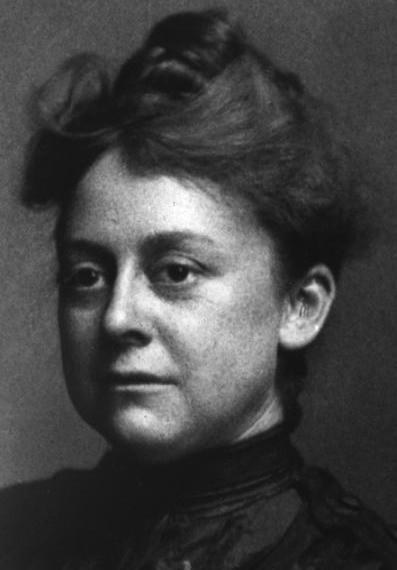
Portrait picture of Alaska, presumably in 1922, via Wikimedia, which posted this public domain image
Recently, in going through some documents made searchable and digitized by the Library of Congress, I came across one Alaska Packard Davidson, who is described on her Wikipedia page as "an American law enforcement officer who is best known for being the first female special agent in the FBI." At age 54, she joined the Bureau of Investigation (BOI) in October 11, 1922 as a special investigator, with a starting salary of $7 a day, which went up to $11 a day when traveling, first working at the New York office (where she went for training), then at the Washington office. [1]
Although the BOI, the FBI's precursor, wanted to hire women for cases related to combating intersex sex trafficking, she was considered "refined" so she wasn't put on such cases, meaning the BOI considered her of "limited use" in prosecuting such crimes, partially due to her limited schooling. [2] Instead, she was involved in a case against an agent who sold classified DOJ information to criminals, for example. [3] After the resignation of her former boss, William J. Burns, who was caught up in the Teapot Dome Scandal, she was forced out by J. Edgar Hoover, who had become the Bureau's acting director in 1924. He asked her to resign after the special agent leading the Washington field office, E.R. Bohner, said he had "no particular work for a woman agent."
She resigned on June 10 of the same year, even though there was no indication her work was unsatisificatory. Before that point, she still was able to transmit information to the BOI on the Fourth International Congress of the Women's International League for Peace and Freedom (WILPF), a women's peace activist group, in May 1924, under the name of A.P. Davidson, informing the agency, including Hoover, about their activities, because they claimed that Jane Addams was committing "treason" (a lie). [4] Following her, and with the resignation of other agents in the 1920s (Jessie B. Duckstein and Lenore Houston), the BOI, then FBI, had no female agents for 43 years, between 1929 and 1972! There is more to her life than her brief stint in the BOI, crossing some ethical boundaries by spying on WILPF by telling the BOI about its activities. Despite this, the agency still celebrates (also see here) her, despite the problematic history, as I just described, and role of Hoover in her ouster from the BOI.
Here's what we do know. Alaska "Al", likely named after the then-territory of the same name, was born in Ohio, on March 1, 1868, to Warren Packard and Mary Elizabeth, with her two brothers, James Ward and William Doud, who both founded the Packard auto company. She was first listed in the 1870 census as a 2-year-old girl, with James and William in the house, as was her 1-year-old sister Carlotta, and the household headed by Warren, a hardware merchant, and his wife, Mary. [5] In 1880, she was living with her parents, siblings (William, James, and Carlotta) in Chautauqua, New York. She had another sister, named Cornelia Olive, as well.
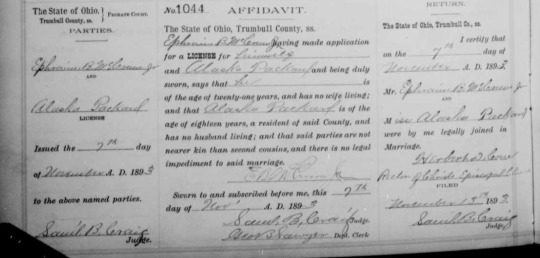
Via "Ohio Marriages, 1800-1958", database, FamilySearch, 25 March 2020, Alaska Packard in entry for Ephraim B. McCrum, 1893, Marriage Record Vol. 10: 1890-1895, Trumbell County, Ohio page 348, image number 214 of 638. This was also confirmed by a 1897 newspaper clipping which called her "Mrs. E. B. McCrum."
Al had been in public school for three years and did not have a college, or university education. Cindee Mines notes on the Trumbell County Historical Society (TCHS) website that she grew up as the daughter of a wealthy territory, living in a huge mansion "on High Street at Mahoning Avenue in the mid 1870’s," and that while there is no evidence she had any higher education, she was a "well-known equestrian, winning awards at county fairs in her teenage years," even put in charge of the "New York and Ohio plant" for Packard Electric in 1890. Beyond that, she married two times. In 1893, she married a man named Ephraim Banks McCrum Jr., a close friend of her father, in Trumbell County, Ohio, as shown above. She had a daughter named Esther in 1894. [6] In 1900, the federal census showed her as married and with one child, while also confirming she had been married for seven years. [7] By then, however, she had, according to the aforementioned TCHS biography, had divorced Ephraim, with Esther living in a Columbus hospital known as the “Institution for Feeble-Minded Youth”. The same census showed her living with her widowed mother, Mary, brothers W.D. and William, and sisters, Carlotta and Cornelia. Esther sadly died in 1902 at the age of 8, of pneumonia, although TCHS said it was tuberculosis. [8]
At some point before 1910, she married a man named James B. Davidson, who was well-known to the Packard family. She is shown in the 1910 census as his wife, living in O'Hara Township, Allegheny, Pennsylvania, with two boarders: a 32-year-old man named Fred Osterley and an 18-year-old woman named Jessie Osterley. [9] A land record the previous year noted Al and James Ward Packard owning a tract of land named Lakewood in Chautauqua, New York. [10] The THCS biography says she purchased over 100 acres in Accotink, Virginia, which is near Mount Vernon, an unincorporated area in Fairfax County, living there with horses and a dog.
By 1920, she was living in Mount Vernon, Fairfax, Virginia, with James and a 16-year-old servant, from Maryland, named James Cot. [11] In 1925 she joined a petition to the New York Supreme Court for an appraisal transfer tax. Then came the letters between herself and Carrie Chapman Catt in 1927. On May 26, Carrie told her about a story from Harriet Taylor Upton, assuming it was a man who came to her with a list of suffragettes compiled by the Bureau of Investigation (BOI), thanks to information from Ms. Mary Kilberth (a leading anti-suffragist) and Robert Eichelberger, the husband of famed suffragist Bessie R. Lucas Eichelberger. She says the list is from the Secret Service, but I think she means the BOI. She then said that she was writing an open letter to the D.A.R., because the first individual was part of it, saying that this material is fodder to anti-suffragists. She then added:
In view of the fact that you no longer are connected with the Department [The Bureau of Investigation], I think you might allow me to make this statement. In the event the government should make inquiry, which it is not likely to do, as to who this person was and I was driven in a corner, I might have to give your name. I do not think you would need to apologize and I believe that your name would not be asked for. I would certainly not give it unless I was driven to it and, indeed, I would agree not to give it until I had again consulted you, letting you know what the condition is under which the pressure has been made.
On May 30, Al responded, saying that she would be fine to use her name, forgetting most of the women on "Miss Kilbreth's list" and said that Kilberth accused Catt "of something…in connection with your South American trip and she couldn't say enough against Mrs. Upton." The final letter in this file is Carrie's reply on June 25. She first apologizes for not acknowledging the letter more promptly, and said two people will be sent to her, stated her intention to write about this incident, and concluded by saying "it is a pity that the anti-suffragists are such poor sports that they cannot overcome their disapproval of us." What I take from this whole exchange is that Al was a suffragist, which really isn't much of a surprise, and that the BOI had compiled a list of suffragists, for who knows what end.
But that's not the whole story. In a May 27, 1927 letter from Harriet Taylor Upton to Carrie, Harriet says the D.A.R. is lifting up an anti-suffragist member, and even noted that she pushed for more women to be appointed within the government, including Al. She proceeded to give a brief description of Al, which gives details about her life:
When I went to Washington in the Republican [Party] Headquarters, I tried not to get places for anybody in government. I did a great deal towards the appointment of women to key positions, but not regular government positions. I made one exception and that was the daughter of a citizen of Warren whom I had known for years. She is the sister of the Packard men who made the Packard machine. She had married rather unfortunately and was living in a little town down in Virginia. She had experience in office work, is splendid at managing people and I asked Harry Daughterty, the Attorney General, if he could find a place for her. She expected just a small place of a thousand dollars or so, and would drive back and forth from her plantation, which is a part of the Washington estate. We were surprised to have him appoint her to the Secret Service Commission [BOI?] and she worked under [William J.] Burns, the great secret service man. She got $2300.00 a year salary and she did a corking [splendid] job. It was just the kind of a job she could do. They finally took in another woman who proved to be a discredit to women and to the department and everything else.
Now in the beginning when Mrs. Davidson began her work in this department, she would come to me asking about the loyalty of this person and that person and in the course of the time she was there, I learned that Miss Kilbreth of the Patriot was stuffing the Attorney General's office with all of the lies possible. Now one day Mrs. Davidson came in with a list of names and among them were our people. I have forgotten now just who was on the list, but it was our own folks and they were just about as much traitors to the government as we are now. I therefore told Mrs. Davidson that that whole thing was just made up, and she said she had about concluded that this was true for she has always been devoted to me, and Miss Kilbreth told her awful things about me. She thought if things were no truer about other people than they were about me, there was nothing to it. I had forgotten that I ever reported this to you. I had forgotten that she threw the list in the waste basket. Of course I did not write that it was a woman who gave me the information, because I did not want anyone to know then that the secret service through personal friendship were consulting me. And you must have taken it that it was a man because all people employed were men...I do not know whether Mrs. Davidson would have any objection to your using her name or saying that it was a woman from the Attorney General's office or not. If you want me to I can write to her, or if you want to you can write direct to her, telling her what you want it for. She is out of the thing entirely now and never will get back because Mr. Daugherty is no longer there and because I am no longer there. Her address is Mrs. James Davidson, Acotink, Va.
Harriet hen goes onto say that she might sever her membership with the D.A.R. I would like to know if the D.A.R. was filled with suffragists at the time, or if Harriet was boasting. After all, Susan B. Anthony, Emily Parmely Collins, Carrie Chase Davis, and Alice Paul were recorded as members of the D.A.R. Al showed good judgment by throwing away the list of suffragists in the waste basket. Someone needs to make a film or animation of this. It would be great! There are other Packards mentioned in the papers, like a "Mrs. Packard" in Springfield, Massachusetts who is the vice-chairman for a "Mrs. Ben Hooper." [14] Also, considering that Carrie was, at the time, in a relationship with Mary "Molly" Garrett Hay, after her second husband, George Catt died in 1905, is it possible she was attracted to Al, even from their short exchange? More pertinent, it says something about the close friendship that Al and Harriet had for Harriet to comment that Al "married rather unfortunately" and say that Al "has always been devoted" to her. Maybe the friendship went further than that? In any case, Al was still married to James at the time. Even so, it appears that Harriet recommended Al for the job, at least if this letter is to be believed.

Al Packard as a teen, via the Classic Cars Journal
Three years later, in 1930, Al was widowed and still living in Mount Vernon, at a house worth about $4,000. [15] And yes, she lived alone, had a radio and no occupation listed, which is not a shock for someone 62 years old. Although she was alone, we don't know whether she had close friends or family members which kept her company, although it is possible. She was described as widowed because James had died in May 1929. It is not known whether she and Carrie, or she and Harriet ever met each other after the death of James in 1929. Keep in mind that the marriage Harriet had with a man George W. Upton, who she had been with since 1884, ended in 1923. According to the TCHS biography, she continued living on the farm until her death.
She died four years later, on July 16, 1934, in Alexandria, Virginia, at the age of 66 of various causes. [16] She lived on in many realms. She was mentioned in the episode "Waxing Gibbous" of the eighth season of Archer, a mature animation, which was described by The A.V. Club as an obscure reference, and praised by Vulture. In chapter two of Gloria H. Giroux's Crucifixion Thorn: Volume Two of the Arizona Trilogy, a character is inspired by Al, while others chattered on Twitter about renaming the FBI building after her. As some of her ancestors put it, she lived an "unusual life." She definitely did, without a doubt! There are many avenues and chances to branch out with this article, for someone who is my sixth cousin three times removed, to other topics and I hope you all enjoyed this post.
Notes
[1] Theoharis, Athan G. (1999). The FBI: A Comprehensive Reference Guide. Greenwood Publishing Group. pp. 321–322. ISBN 9780897749916; Mullenbach, Cheryl (2016). Women in Blue: 16 Brave Officers, Forensics Experts, Police Chiefs, and More. Chicago Review Press. ISBN 9781613734254; Vines, Lynn. "The First Female Agents," The Investigator, p 77-78
[2] Delgado, Miguel A. (February 4, 2017). "Alaska Packard, la primera agente del FBI despedida por ser mujer". El Español (in Spanish). Retrieved January 16, 2021; Theoharis, Athan G. (1999). The FBI: A Comprehensive Reference Guide. Greenwood Publishing Group. pp. 321–322. ISBN 9780897749916.
[3] Mullenbach, Cheryl (2016). Women in Blue: 16 Brave Officers, Forensics Experts, Police Chiefs, and More. Chicago Review Press. ISBN 9781613734254. Her testimony before a House select committee in that case in May 1924 is shown on pages 2492 to 2495 of [Investigation of Hon. Henry Daughtery Formerly Attorney General of the United States] Hearings Before the Select Committee on the Investigation of the Attorney General, United States Congress, Senate Sixty-Eighth Congress First Session Persuant to S. Res 157 Directing a Committee to Investigate the Failure of the Attorney General to Prosecute or Defend Certain Criminal and Civil Actions Wherein the Government is Interested: May 15, 16, 17, 20, 21, and 22, 1924 [Part 9] (Washington: Government Printing Office, 1924).
[4] Davidson, A.P. "Re - Women's International League of Peace and Freedom: Report of Fourth International Congress," File 237, May 7, 1924, within "Jane Addams Part 1 of 4," FBI, The Vault, Pages 2-9; Davidson, A.P. "Re - Women's International League of Peace and Freedom: Report of Fourth International Congress," File 4237, May 5, 1924, within "Jane Addams Part 3 of 4," FBI, The Vault, Pages 18-25; Davidson, A.P. "Re - Women's International League of Peace and Freedom: Report of Fourth International Congress," May 5, 1924, within "Jane Addams Part 3 of 4," FBI, The Vault, Pages 26-39; Davidson, A.P. "Re - Women's International League of Peace and Freedom: Report of Fourth International Congress," May 5, 1924, within "Jane Addams Part 3 of 4," FBI, The Vault, Pages 40-46, continued in "Jane Addams Part 4 of 4," FBI, The Vault, pages 1-6. Parts of her report may also be on pages 1-29 of "Jane Addams Part 2 of 4." Her reports didn't matter, as Meredith Dovan wrote, on page 18 of her thesis, "FBI Investigations into the Civil Rights Movement and the New Left" that "Hoover fired both women [Alaska and Jessie B. Duckstein] during a round of cuts after he became acting director of the FBI in May 1924."
[5] “United States Census, 1870,” database with images, FamilySearch, James W Packard in household of Warren Packard, Ohio, United States; citing p. 21, family 5, NARA microfilm publication M593 (Washington D.C.: National Archives and Records Administration, n.d.); FHL microfilm 552,771; "United States Census, 1880," database with images, FamilySearch, 13 November 2020, Alaska Packard in household of Warren Packard, Chautauqua, New York, United States; citing enumeration district ED 39, sheet 30B, NARA microfilm publication T9 (Washington, D.C.: National Archives and Records Administration, n.d.), FHL microfilm 1,254,815.
[6] "Ohio, County Births, 1841-2003", database with images, FamilySearch, 1 January 2021), Alacha Packard in entry for Esther McCrum, Birth registers 1883-1896 vol 3., page 184, image 183 of 289.
[7] “United States Census, 1900,” database with images, FamilySearch, William Packard in household of Mary Packard, Warren Township Warren city Ward 1, Trumbull, Ohio, United States; citing enumeration district (ED) 120, sheet 13A, family 297, NARA microfilm publication T623 (Washington, D.C.: National Archives and Records Administration, 1972.); FHL microfilm 1,241,325.
[8] "Ohio, County Death Records, 1840-2001," database with images, FamilySearch, 14 December 2020, Alaska P. Mc Crum in entry for Esther Mc Crum, 20 Apr 1902; citing Death, Columbus, Franklin, Ohio, United States, source ID v 3 p 240, County courthouses, Ohio; FHL microfilm 2,026,910.
[9] "United States Census, 1910," database with images, FamilySearch, accessed 16 January 2021, Alaska Davidson in household of James B Davidson, O'Hara Township, Allegheny, Pennsylvania, United States; citing enumeration district (ED) ED 185, sheet 10A, family 212, NARA microfilm publication T624 (Washington D.C.: National Archives and Records Administration, 1982), roll 1296; FHL microfilm 1,375,309.
[10] "United States, New York Land Records, 1630-1975", database with images, FamilySearch, 27 December 2020, Alaska P Davidson in entry for James Ward Packard, 1910, Grantees 1902-1910 vol A-Z, image 564 of 811, page 592. The liber is noted as 388 and the page as 477, but this volume appears to not be digitized as of yet.
[11] "United States Census, 1920", database with images, FamilySearch, accessed 4 January 2021, Alaska Davidson in household of J B Davidson, Mount Vernon, Fairfax, Virginia, United States, citing enumeration district (ED) ED 36, sheet 7B, family 130, NARA microfilm publication T625 (Washington D.C.: National Archives and Records Administration, 1982), roll 1886; FHL microfilm 1,821,886.
[12] Catt, Carrie Chapman. Carrie Chapman Catt Papers: General Correspondence, Circa 1890 to 1947; Davidson, Alaska P. - 1947, 1890. Manuscript/Mixed Material, pages 1-3, Letters on May 26, 1927, May 30, 1927, and June 25, 1927.
[13] Catt, Carrie Chapman. Carrie Chapman Catt Papers: General Correspondence, Circa 1890 to 1947; Upton, Harriet Taylor. - 1947, 1890. Manuscript/Mixed Material, pages 3-4.
[14] Catt, Carrie Chapman. Carrie Chapman Catt Papers: General Correspondence, Circa 1890 to 1947; Hooper, Mrs. Ben; 1927 to 1929. - 1929, 1927. Manuscript/Mixed Material, pages 18, 21, and 24.
[15] "United States Census, 1930," database with images, FamilySearch, accessed 16 January 2021, Alaska P Davidson, Mount Vemon, Fairfax, Virginia, United States; citing enumeration district (ED) ED 18, sheet 18B, line 53, family 404, NARA microfilm publication T626 (Washington D.C.: National Archives and Records Administration, 2002), roll 2442; FHL microfilm 2,342,176.
[16] "Virginia, Death Certificates, 1912-1987," database with images, FamilySearch, 16 August 2019), Alaska Packard Davidson, 16 Jul 1934; from "Virginia, Marriage Records, 1700-1850," database and images, Ancestry, 2012; citing Alexandria, , Virginia, United States, entry #15826, Virginia Department of Health, Richmond.
Note: This was originally posted on Jan. 21, 2021 on the main Packed with Packards WordPress blog (it can also be found on the Wayback Machine here). My research is still ongoing, so some conclusions in this piece may change in the future.
© 2021-2022 Burkely Hermann. All rights reserved.
#fbi#fuck the fbi#alaska packard#alaska packard davidson#20th century#doj#j. edgar hoover#ohio#warren packard#william doud packard#james ward packard#packard car company#packards#packard#marriage#tuberculosis#pennsylvania#mount vernon#chautauqua#viriginia#surveillance#lesbians#dar#lgbtq
2 notes
·
View notes
Text


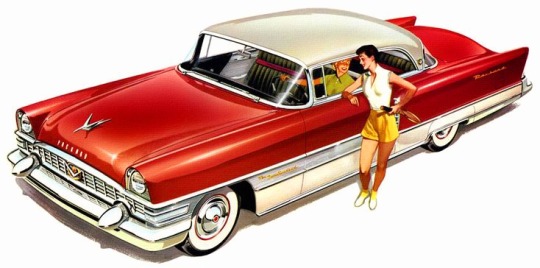


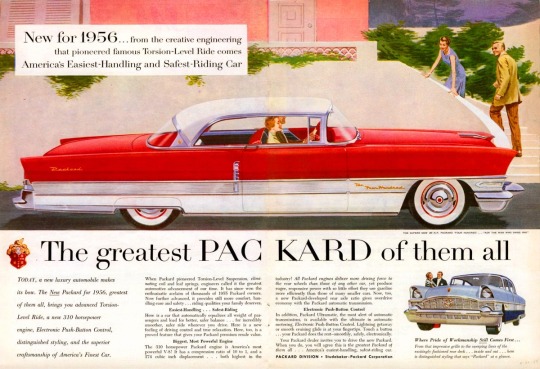




🇺🇲 Let's explore the captivating story of The Packard Four Hundred—a symbol of luxury and prestige in mid-20th century automotive history! Introduced during an era of opulence and innovation, The Packard Four Hundred captivated drivers with its exquisite design and unrivaled craftsmanship.
🚘 The Packard Four Hundred made its debut in 1955 as the flagship model of the Packard lineup, representing the pinnacle of automotive luxury and elegance. Boasting sleek lines, chrome accents, and a commanding presence on the road, it quickly became a symbol of status and sophistication.
🛞 Beneath its elegant exterior, The Packard Four Hundred showcased advanced engineering and cutting-edge technology. Equipped with a powerful V8 engine, it delivered smooth and effortless performance, while its plush interior offered unmatched comfort and refinement for passengers.
💔 Despite its initial success and acclaim, production of The Packard Four Hundred came to an end in 1958. One of the key factors contributing to its discontinuation was the changing landscape of the automotive industry, marked by increasing competition and shifting consumer preferences.
🌟 Nonetheless, The Packard Four Hundred remains a symbol of automotive excellence and craftsmanship, leaving an indelible mark on the history of American automobiles.
#brits and yanks on wheels#retro cars#transatlantic torque#vehicle#cars#old cars#brands#companies#automobile#american cars#made in america#made in usa#packard#studebacker packard corporation#studebaker packard#detroit#michigan#packard 400#packard the four hundred#1950s cars#1950s history#1950s#1950s fashion#retro#vintage#vintage cars#retro aesthetic#old car#cool cars#classic cars
14 notes
·
View notes
Text
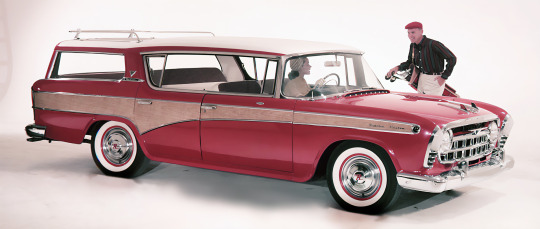
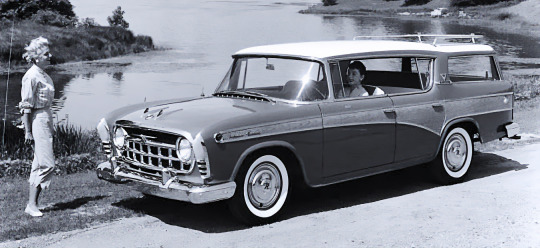
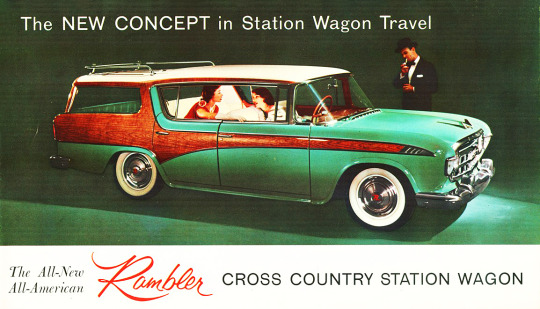


Rambler Custom Cross Country Hardtop Station Wagon, 1956/57. Rambler was the first company to offer a pillarless station wagon in 1956 (green car). It was one of the first with a roll-down rear window instead of a liftgate. AMC were also offering their own V8 engines from 1956, previously they had used a Packard V8
#Rambler#Rambler Custom Cross Country#Rambler Custom Cross Country Hardtop#station wagon#long roof#pillarless hardtop#first of its kind#AMC#1956#1957#1950s#dead brands
336 notes
·
View notes
Photo
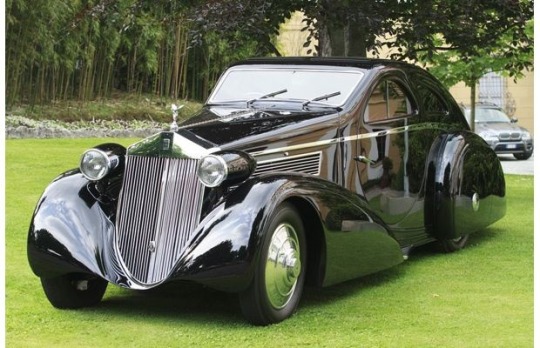

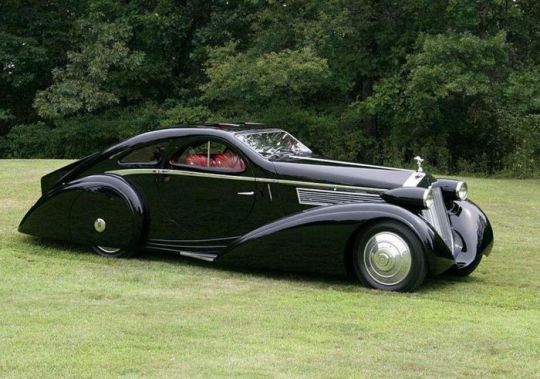

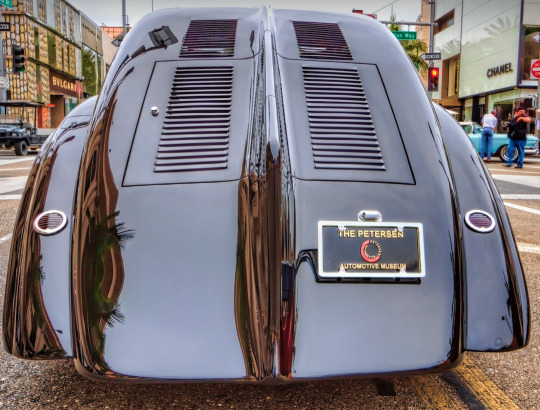
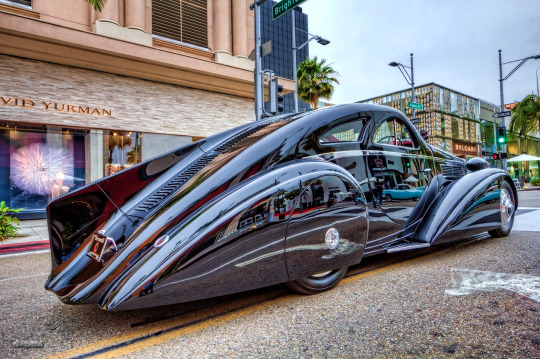




Rolls-Royce Phantom I Jonckheere Coupe
The first Rolls-Royce Phantom — then called the New Phantom, presently called the Phantom I — was introduced in 1925 in response to competition from European luxury marques like Hispano-Suiza and Isotta Fraschini and from premium American automakers like Packard and Pierce-Arrow. Based on the chassis of the outgoing 40/50 model, now known as the Silver Ghost, the Phantom introduced Rolls-Royce's first overhead valve engine and four-wheel brakes (although some sources say front brakes were introduced in late production Silver Ghosts). The OHV engine was taller than the sidevalve motor. That affected styling. The bodies coach built for the Phantom I had higher hoods, radiator shells and cowls.
In 1934, an as-yet-unidentified owner took the Phantom to the Jonckheere body company near Roeselare, Belgium to be rebodied. Though Henri Jonckheere built his first luxury automobile in 1902, the company had transitioned to making mostly bus and coach bodies by the 1930s. It still exists today as VDL Jonckheere.t’s not known who designed it, but Jonckheere built a radically different coupe body. Some say it was inspired by the aero designs of stylists Jacque Saoutchik and Joseph Figoni — but, to my eyes, it’s not nearly as elegant and flowing as their work. The squarish Rolls-Royce grill was retained, but it was sloped back to give the tall grill a more streamlined look. It is perhaps the only classic era Rolls-Royce whose grill is not vertical. To say the least, the car is a bit controversial with traditional Rolls-Royce enthusiasts. The windshield is also steeply raked. Bullet headlights and very long and flowing fenders continue the streamlined theme, but the car is so massive it’s hard for me to call it sleek. To finish off the aero look, Jonckheere put a big tailfin down the length of the middle of the trunk lid. Such fins were popular with European coachbuilders in the 1930s and you can see them on Bugattis, Delahayes and other custom-bodied cars of the era. Designer Raymond Loewy added one to his customized 1939 Lincoln Continental.
Of course, the Rolls’ most distinctive features are its large rear-hinged round doors, which allow ingress for both front and rear passengers. Because of the odd door shape, the side windows are split vertically and open up like a scissors as they retract into the doors. Round fender skirts for the rear wheels echo the shape of the doors.
The car is almost 20-feet long and finished in dark black. It’s a big, almost ominous looking vehicle that would be at home in a Batman movie, driven by the villain.
It’s not a very practical car. With ponderous weight and no power assist, the steering is difficult, particularly at low speed. The non-synchro transmission needs to be double clutched and, even though the car features Rolls-Royce’s servo-assisted mechanical brakes, the weight makes it hard to stop. The large turning radius, low ground clearance and extended rear end make maneuvering the vehicle difficult. The steeply sloping fastback roofline forces rear passengers to slouch. There is no back window to speak of, just louvers, so visibility isn’t the best. To make the most of the limited trunk space, there is a set of fitted luggage.
#Rolls-Royce Phantom I#Hispano-Suiza#Isotta Fraschini#Packard#Pierce-Arrow#Jonckheere#Lincoln Continental
246 notes
·
View notes
Note
CONTACT YOUR GOVERNMENT AND DEMAND A CEASEFIRE FOR PALESTINE
For Eu look up:
Voices in Europe for peace
For Usa look up:
US campaign for Palestinian rights
BOYCOTT FOR PALESTINE
FOA (Friends of Al-Aqsa) have organized a boycott in support of palestine. Here are the key companies to boycott:
HP (Hewlett Packard)
Coca-Cola
Israeli produce
We will be ending our call to boycott PUMA once the contract with IFA officially dissolves in 2024. Until then, we encourage you to continue boycotting PUMA products.
(Please help to spread the word by spreading this copypasta online and/or going to FOAs website where you can find posters to print out)


This is Hind Rajab. A six year old Palestinian girl who was murdered while receiving medical care in Gaza after an IDF tank attacked her family car. She spent 12 days in a destroyed ambulance.
If you are somehow still on the fence about this war, I am pleading with you to understand. It’s no longer a war, it never was. It’s not about defending Israelis or destroying Hamas. It’s about killing the Palestinian people. This is genocide.
From the river to the sea. 🇵🇸
25 notes
·
View notes
Text


1930 Packard Eight Convertible Sedan by Brewster
Brewster & Co. of New York had a long and prestigious history dating back to 1810, building “Carriages for the American Gentleman,” a slogan they would later adopt. Best known for their work with Rolls-Royce of America, Brewster also built bodies for numerous other companies including a line of cars for Packard. At seven thousand dollars this was one of the most expensive cars offered by Packard in 1930. The Packard Model 745 chassis under this car is considered one of the best of the custom coach building platforms, due to its enormous wheelbase, powerful engine and long hood.
SPECIFICATIONS
Model: Convertible Sedan
Wheelbase: 145.5 inches
Engine: 384.8 cu. In. straight eight
Horsepower: 106 BHP @ 3600 rpm
Transmission: Three speed-manual
Brakes: Mechanical Drum Brakes
Curb Weight: 4,645 lbs.
Price When New: $7,005
25 notes
·
View notes
Text
Cars and Trains in Spy x Family Ep. 1
Spy x Family is an excellent anime that is officially set in a completely fictional country in a completely fictional world, far outside of any of our actual histories and timelines. Except not really; it’s actually set in east Berlin of the late 1960s. They don’t call it that (instead calling it “Berlint”, of all things), but the amount of detail they put into portraying the setting and the time period is truly remarkable, considering that they didn’t have to at all. Let’s look.
The first car we see in the first few seconds already tells us that this show is going to be a delight if you’re into that sort of thing (it’s also a delight if you don’t care much). An important diplomat gets murdered in his car. And the car is this:

Americans might think that it’s a 1956 Packard Patrician, but it’s not, as the slightly different grill shows. It’s a ZIL 111, the soviet copy of that car. Here’s a real one:
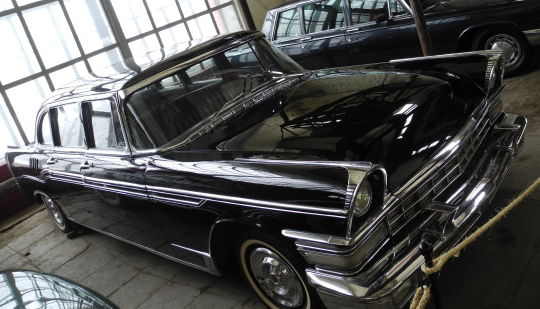
Picture from Wikimedia Commons, by Max schwalbe, published under CC-BY-SA 3.0 license
This was a classic car for important people all over the east bloc, like state ministers and so on. It’s a beautiful rendition and it fits perfectly in this role.
Ignoring some background cars that we’ll get to soon enough, the next car is the coupé Agent Twilight drives away from the fake information trade set up:
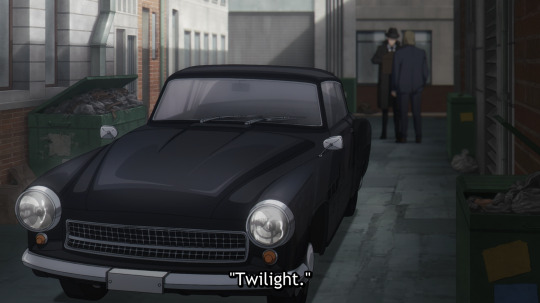
That is a Wartburg 311/3, two-dour coupé version of the original Wartburg 311.

Picture from Wikimedia Commons, taken by Torsten Maue, published under CC-BY 2.0 license
I’ve been told that Wartburg sounds weird in english, but in case you’re wondering, it’s the name of the castle near Eisenach (where this car was built), most famous for being the place where Martin Luther was imprisoned for a while and translated parts of the bible. The Wartburg 311/3 was not a mass product, and the whole Wartburg 311 line was soon supplanted by a more famous boxy version, but this is still a classic example of east german car construction.
Then Twilight has to leave for Berlint on a train, and the engine is, of all things, this:

It’s even more clear in the manga:
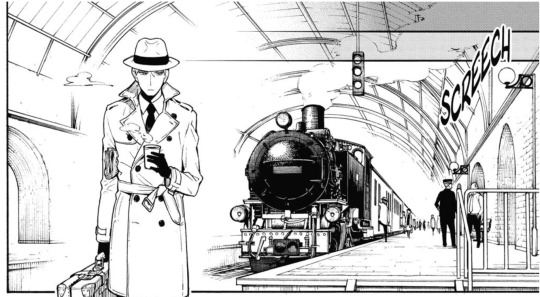
This locomotive is an east german class 99.77-79 steam locomotive, built from 1952 to 1956. Here are two of them together in Cranzahl:

Picture by me, feel free to use under CC-BY-SA 3.0
These locomotives fit into the time frame and into east Germany as a setting, but they wouldn’t be hauling a train to Berlin. They were built for the 750 mm narrow gauge branch lines of Saxony, and can only run on these narrow tracks. They’re actually still in use today, now as tourist railroads, operated by a company called SDG. Check them out if you’re in the area, these lines are fun.
The passenger coach that Twilight is sitting in does not correspond to anything I know, so the next recognisable thing is the tram that Twilight and Anya use.

This is a tram type “Gothawagen” T4-62. These were used in Berlin and not really much outside of it, and were built from 1961 to 1964 (with some prototypes a few years earlier). Newer types replaced them relatively quickly, but the last ones actually ran until 1996. Here’s a picture of one of them on the same exact line 86:

Picture from Wikimedia Commons, taken by Felix O, published under CC-BY 2.0
If you want, you can point out details that are different, e.g. windows, pantograph or the missing V shape, but the overall impression is very clear. Whoever designed this knew what they were doing.
As the episode concludes, we see a beautiful picture of east german road traffic, featuring two of these trams and in front a Wartburg 353, which I’ll talk about when discussing later episodes:

Beautiful. Yes, the show is made for people who like found family and silliness, and it’s lovely in that regard. But it’s also made for history nerds who get excited about old trams and cars, and in that regards it’s absolutely perfect as well.
Here’s the post for episode 2
118 notes
·
View notes
Text

After V-E Day (peace in Europe) was declared on May 8, 1945 and later on when V-J Day (peace in Japan) was declared on August 15, 1945, the average age of what was on the road was nine years old. There was such a pent-up demand for new cars that it made no sense to redesign cars early. Many new cars were just warmed over 1942 models. There's an old adage that says, "Beauty is in eye of the beholder" and as the postwar Seller's Market slowly transitioned to a Buyer's Market that by 1949, four of the Independent car manufacturers would design some unique and radical looking cars. Independent automakers earn a 22 percent market share in 1948 versus just 9.3 percent in 1941.
Studebaker was the first company to redesign their line of cars in 1947, along with their catchy slogan, “First by far with a postwar car." Studebaker was highly successful. Then in 1948 both Hudson and Packard introduced their all-new postwar designs. The Hudson was a radically designed automobile known today as the "Step-down" Hudson. While Packard's all-new design was very successful for the company. Finally in 1949, Nash would introduce their cutting edge design. Out of the four automobiles that were introduced between 1947 and 1949 three looked like they attended the "upside down bathtub" school of design.
In 1948 Hudson introduced one of the best postwar designs that would continue through 1954. The new Hudson was low and sleek, with a low center of gravity allowing it to handle extremely well for the period. They quickly gained renown for superior handling and road-worthiness. Step-Down refers to Hudson's innovative body design that allowed the floor of the car to be placed lower than the frame-rails and door stills. This design allowed the driver and passengers to step down as opposed to stepping up as was the case with the other cars that were produced at that time. The occupants were fully surrounded by steel girders that Hudson called Monobilt construction which meant that the body and chassis were welded together. A long wheelbase ensured a comfortable ride and roomy interiors. The pontoon look, that was a radical departure from the fat fender look started in the mid-1930's and was retained until 1954. The pontoon look blends the front and rear fenders into one continuous line. It was soon copied by other automakers: Packard, Ford, Mercury, and Lincoln. The 1948 Hudson was offered in four trim levels: Commodore Six and Eight and Super Six and Eight they all had a 124-inch wheelbase. Weight rose by 13 percent, but the six-cylinder engine was new and more powerful. These new Hudson models brought Hudson prestige in the press and dominance on the race track while in the showroom Hudson's sales were up by 27 percent to 117,200 which was good for 10th place in industry sales. Hudson earned a $13.2 million profit on $274 million in sales, setting a new postwar record. The Step-Down Hudson evolved from wartime designs by Frank Spring, and chief engineer Millard Toncray. The Commodore Six ran with a sensational, durable new engine a 262-cid L-head that produced 121 bhp that put other eight cylinder cars to shame. The other engine was available on the Commodore Eight which had the 254-cid L-head eight rated at 128 bhp.
A point that is often overlooked in Hudson's history, is the choice that Hudson made to go to unitized body construction, where the body and chassis are welded together. This was a very advanced process that did allow for lighter weight and more chassis stiffness and when combine that with the ability to lower the structure (you sat in the frame, not on top of it), the Hudson cars were more advanced then their competition. However, unitized construction requires much more tooling costs to redesign the body style because you are changing the structure as well as the body sheet metal. That led to the Hudson styling remaining unchanged for seven years which was way too long to satisfy the customer especially when the competition was redesigning every few years. The second thing that hurt Hudson badly was the refusal to introduce a modern V-8. It is ironic that their choice to upgrade their Super Six to the 308-cid Hornet L-Head resulted in a quite powerful engine. Hudson Hornets had 165 horsepower when most competitors were making no better than 135. The third and most telling was the disaster of the Jet. Hudson had limited financial resources, and management decided to develop a compact-sized model instead of refurbishing its line of full-size cars and developing its own V-8. However, Hudson was unable to foresee the dramatic decline in overall compact car sales during the 1952-1954 period which already included three other makes The miscalculation of the Jet helped to destroy the Hudson Motor Car Company. Consequently, the company was forced to merge with Nash-Kelvinator (forming American Motors on May 1, 1954) because of the losses resulting from the Jet project and the falling sales of Hudson's senior line.
Packard outsold Cadillac by almost 20 percent in 1948, but it was for the last time. Although Packard ultimately posted a net profit of $5.3 million for the calendar year, ongoing problems with production and raw materials resulted in operating losses through much of the year. Sales for the 1950 model year declined sharply, as did Packard’s market share, which fell by more than 30 percent from 1948 to 1950. Packard did not adhere to the conventional model year designations until 1951. These models were built from August, 1947, through May, 1949 and were considered the Series 22. The first of these Packard models appeared in August 1947 as convertibles. Packard's 1948 profile was based on the prewar Phantom show car that was built for Ed Macauley. Appearance changes included a longer hood; "ox-yoke" shaped upper grille; full-width, wraparound lower grille; a pair of simplified, vertical front bumper guards; and smoother, rounded body lines, often referred to as the "inverted bathtub" or "soap bar" look. The new Packard body styling was awarded a "Fashion Car of the Year" gold medal by the New York Fashion Academy. At exhibits throughout the world in 1947-1948, the new Custom Victoria Convertible Coupe was honored for its advanced styling. A dashboard with black-lighted "Flite-Glo" instrumentation was a new feature, and tool kits were provided with each new Packard sold. Heavy chucks of sheet-metal were tacked onto the structure to create a flowing-fender effect that added about 200 pounds and yielded a chubby profile. Unfortunately, sharp eyed car buyers nicknamed Packard the, "Pregnant Elephant." A short squat grille did not help matters, as it was far less elegant then the tall narrow grille of the 1946 and 1947 models. For 1948 a new top-of-the-line 327-cid 145-horsepower engine was available for the first time in the Super series. Packard made eight-cylinder engines in 288, 327, 356-cid, these were rated at 130, 145 and 160 horsepower, respectively. Packard's six cylinder engine was reserved for the taxi and limousine models only selling around 2,000 cars. The wooden body work (maple panels framed with birch) of the Station Sedan (station wagon) was structural only at the smallish tailgate. Wood at the door panels and window frames were inlaid.
The Standard Eight had the plainest Packard hood ornament, single rocker panel strips, upper belt moldings running from below the front vent panes to the rear, and no lower belt moldings at mid-body level as did the more expensive models. While the DeLuxe Eights were the same basic cars as the Standard Eight with extra exterior trim and better interior appointments that were also fitted to the Super Eights. As in years past, Packard offered several hood ornaments. Standard on the Packard Eight, was a low "flying wing," but buyers could opt for the "Goddess of Speed," irreverently known as the "boy with the donut," or the "Egyptian," which looked like a fancied 1949 Ford hood ornament. Standard on the Custom Eight was the graceful Cormorant, which Packard would call the Pelican in 1949-1950. DeLuxe Eight models were also fitted with a fancier wheel treatment. The Super Eight was Packard's mid-priced line of cars that had nicer interior materials. Exterior trim was little different than that of the Standard Eights, except for the Super DeLuxe sedan, which was trimmed in the manner of the DeLuxe Eight. In the rear there chrome divider bars on the tail light lenses. At the top was the Custom Eight which was Packard's luxury series, it had the highest horsepower output, but due to their larger size, not the highest power to weight ratio. The egg-crate style grille design was exclusive to the Custom Eight and a beauty panel, of a similar pattern stretched across the rear body to encase the tail-lamps with its bright metal scroll design. Rear wheel fender skirts were standard equipment and a double rocker panel strip ran the full length on the body sides. A graceful, vertical cormorant mascot was this model's hood ornament. Also introduced in 1948 was the all-new Super Eight Victoria Convertible Coupe it was Packard's first open car since 1942. The Super convertible had a single rocker panel strip and fender skirts were standard while the wheelbase was 120 inches while the interior materials was all-leather. Model year production for Packard jumped to 81 percent to 92,251 cars sold for 13th place in the industry.
When Charles W. Nash died on June 6, 1948 in Beverly Hills, California he left an estate worth around $50 million dollars. Nash who founded the company had hand-picked George Mason as his successor, partly on the belief that Mason was a fiscal conservative like himself. It's doubtful that Nash ever regretted his choice, for Mason ran the company very well indeed, avoiding the pitfalls that had killed off so many other independent automakers. On October 27, 1936, it was announced that Nash Motors and the Kelvinator Corporation would merge on January 4, 1937, to form Nash-Kelvinator Corporation that placed George W. Mason at the helm of the combined company. By 1945, Nash was a solid company that had earned a reasonable return on its wartime contracts and had plenty of cash on hand to retool for the future. Mason understood the need for fiscal responsibility, but a part of him yearned to take a chance on something a bit daring, bold, and out of the mainstream. He believed that the way to ensure success for a smaller independent automaker was to offer cars noticeably different from those of the Big Three. Mason realized that once the pent-up demand was over the market would quickly turn cold and cruel. Knowing that he would need an all-new car when competitive conditions returned, he settled on 1949 as the year he would introduce the first all-new postwar Nash. This would be the car that would lead the firm into the future.
Preliminary work on the 1949 had actually begun during the war, 1943 to be exact. When the 1949 Nash Airflyte was introduced it was a standout, easily identifiable to the man on the street -- exciting and exotic all at once. With its headlines screaming "Now-Everybody Wants It!" The envelope shape was the most streamlined form on the road, a large step ahead of the vaguely similar Packard. The design of the Nash Airflyte generated just 113 pounds of drag at 60 mph, compared to 171 for Packard. The rounded fenders flowed smoothly, their gentle corners eased a path through the wind. At 62 inches tall, the new car stood six inches lower than the 1948 Nash, and the windshield was one piece and curved. Semi-enclosed rear wheel housings had been a feature on the previous Nash models, but for this daring postwar design both front and rear wheels were now enclosed. George Mason championed the enclosed wheels as a boldly innovative feature -- and a Nash exclusive. So pure, was the Aero look that buyers had to come up with an extra $9 if they wanted the "Flying Lady" hood ornament. The only downside was no convertible models and two-door coupes were made. To many eyes the design seems simply the logical extension of the "bathtub" look that had been successfully done at Hudson and Packard.
The interior was just as exciting as the exterior was the "Super-Lounge" interior ("Sky-Lounge" in 1950) which featured a modern minimalist look that was deliberately designed to be recessive in tone and restful to the eye with no distractions. "No need ever to take your eyes off the road . . . all instrument dials are grouped just below eye-level, on your steering post. That's the Uniscope." Tied in with the Uniscope pod was a recessed dashboard: "Everything that could be has been built in, out-of-sight. In addition, the all-coil spring suspension provided a truly luxurious ride, and the Aero design kept wind noise to a minimum. Nash's Weather Eye Conditioned Air System was considered to be the best in the industry. Nash had previously offered a bed option in its cars, but for 1949 it introduced "the new Nash Twin Bed arrangement." The bed (or beds) were formed by dropping the front seat backs to meet the rear seat. Special mattresses were optional, and window screens were soon offered, much to the comfort of campers who wanted to let air in and keep mosquitoes out.
For 1949, Nash converted to unit-body construction exclusively since the new cars shared their chassis as well as their bodies plus there was no extra stiffening underneath the more expensive Ambassador. Nash called it Unitized or Airflyte Construction, and claimed it was 1 1/2 to 2 1/2 times as rigid as conventional cars, partly because of its 8,000 electronic welds. Both series shared identical styling. The 600 series rode a 112-inch wheelbase, while the Ambassador boasted a 121-inch wheelbase. The Ambassador's extra nine inches were ahead of the windshield, so longer front fenders and hood were fitted as well. The body sharing meant that interior dimensions were identical. Both cars were available in just two body styles, a two-door and four-door sedan, though the first was also offered as a Brougham, which differed only on the interior. All were available in three trim levels: Super, Super Special, and Custom. The 600 model came with Nash's four-main-bearing flat-head six displacing 172-cid and was rated at a modest 82 bhp. The Ambassador boasted a larger 234-cid overhead-valve six that put out 112 bhp. Nash's model-year production jump 23 percent to a record 142,592 which was good for 10th place in industry sales and a $26 million profit for Nash.
3 notes
·
View notes
Text

A very early Albion charabanc at the Packard & Pioneer Museum.
Immediately after the stagecoach and before the motor bus was the charabanc. Derived from the French word char-à-bancs ("carriage with wheels"), these vehicles tended to be open-top and consisted of front-facing bench seating.
charabanc services were not overtly popular in Aotearoa, with most companies using either the stagecoach and then service cars (e.g., Newman Bros, Hawkes Bay Motor Company) or just outright began with service cars (e.g., Gubbs Motors).
However, the oldest bus company still in existence in Aotearoa* was founded as a charabanc service (Madge Char-a-banc Motors Ltd, now Madge Coachlines Ltd) in 1920.
This specific Albion arrived in Aotearoa c. 1919, as a military vehicle, it was recovered from a swamp in the 1980s and painstakingly restored to charabanc configuration.
*a title gained in the early 2000s when Newmans Coachlines shot themselves in the foot and went under. Hawkes Bay Motor Company was absorbed into Mt. Cook Line by the 1970s or thereabouts.
4 notes
·
View notes
Photo

I remember going out for dinner as a small boy with my grandmother and her boyfriend. It was a special occasion for me because my family seldom ate out but also because he had a brand new glossy black 1956 Packard Patrician and I loved cars, still do. I remember him saying it was the best Packard he had ever owned and bemoaning the fact that the company would soon be out of business. The merger with Studebaker followed shortly thereafter.
18 notes
·
View notes
Text
Nine Times Non-AMC Vehicles Used AMC Engines - Daniel Strohl @Hemmings
From trucks to racing, the underdog’s V-8s and straight-sixes did a lot
The common misperception about American Motors throughout the years held that the company just assembled cars from other carmakers’ parts, including other carmakers’ engines. While the company did, at times, purchase engines from companies as varied as Packard and Porsche, in fact its engineers developed several lines of…

View On WordPress
5 notes
·
View notes
Text
The Packard Car Company and Samuel Packard, Sr. [Part 3]
I have not found a "Nancy A. Packard" in Pennsylvania yet, but I found a Jasper Packard listed as an Indian Congressman in 1870. While I wasn't successful there, I did find an executors notice for Thomas's estate in December 1851 signed by Ann Packard (likely Nancy Ann) and Newton R. Packard, the executors. Most fascinating of all was a summary of Thomas's life in the Plymouth Pilot of Plymouth, Indiana:
Permit me to announce through the Pilot, the death of Brother Thomas Packard. He was born March 16th, 1778, in Kent county, Delaware--two years after his father [John?] moved to Washington county Penn. He was married [to Nancy Ann Berry] January 28th 1802, and settled in Trumble county Ohio, where he lived until the year 1835, when he moved to this county [Marshall]. He joined the Methodist Episcopal Church in 1811, and remained a member of that Church until the Weslyean's connection connection in America was organized, he then joined that Church, in view of its government and Anti-slavery position. He was a worthy member until he departed this life on the 23d of Nov [1851]. He was a good man, a worthy citizen, a kind father, and an affectionate companion. The Church has lost a worthy member and a devoted friend, but our loss is his gain. He died as he lived, in hope of a blest immortality. A. F.
So, he was born in Delaware after all! The 1850 census wasn't wrong! Using newspapers.com I was able to find that Newton R. Packard was a clerk in Marshall through the 1850s (specifically in 1856, 1857, 1858), even having a building which was burned partially (or wholly) in 1857 fire. Some Packard seems to have run for office in 1860, likely Newton himself. Interestingly, in 1860, a local paper defended Newton from criticism (see here, here, and here) by another local paper of Republican affiliation. Newton was clearly a Democrat, enduring some personal attacks. This may have been important personally since he had a business of some kind, at least in 1854.
Going from here, Thomas Packard is said to have John Harris Packard as his father (it says the same on Find A Grave) and mother as Mary. Sadly, this can't even by proven with Family Search records, as of yet. The Austintown Log House (photos here) wikipedia entry uses one source [3], and within it, the last will and testament, in 1826, of John Packard is quoted:
Knowing that in the course of nature, I must go the way of all the earth, I John Packard of Miander Township County [currently Mahoning] & State of Ohio, I being of good health and sound mind do think it my duty as well as my privilege to make my last will and testament in the following manner. 1st---I will that after my death my body shall be decently buried beside my wife, likewise my funeral expenses and all just debts shall all be paid. 2ed---I will that the property that I do not will be sold as soon as is convinient after my death. 3ed---I will that my daughter Mary take the rent that is due me on that farm which she had of me in Washington County (6 or more?) years at sixty dollars per year. 4th-I will that my son Thomas Packard have five hundred dollars 5th---
I will that my daughter Rachel shall have one hundred and fifty dollars. 6th---I will Rebecca shall have one hundred and fifty dollars. 7th---I will my daughter Catherine's children shall have thirty dollars each. 8th---I will that my son William Packard shall have all that farm which I now live on in Millander Township, Trumbull County, State of Ohio, containing one hundred and 20 acres (81,000 m2), to have and enjoy for ever. 9th---I will that my daughter Nancy shall have one hundred and fifty dollars and my bed and bedding. 10th---I will that my son Garret's children shall have fifty dollars equally divided, each their equal proportion. 11th---I will my son William Packard and John Dowlur, my son-in-law, shall be my Exentors [sic], this my last will and testament in which I set my hand and seal this 29 day of April, 1826. John Packard
This ties John Harris Packard to Thomas, solving another piece of the puzzle. Then, using Geni.com again, one can say John's mother is Abigail Harris and father is Abiel Packard, Jr. However, to make this connection stronger, there must be more proof. Find A Grave gives us the connection of Abiel to his father, Abiel Packard, Sr (and his wife Sarah Ames by extension) as his gravestone says:
Erected
in memory of
Mr. Abiel Packard d[ie]d
Jun [.] the Son of Capt.
Abiel Packard[.] he [the son]
Died Jan[uar]y the 18th
1759 in 31st
Year of his Age
This is great because he is not mentioned in his father's 1774 will. Still, the connection of the generation of Abiel Packard Jr. to that of John Packard is not strong at all.
This is where my family tree on Ancestry.com comes in, so I don't need to use Geni.com and its flimsy sourcing anymore. For Abiel Packard Sr., according to his father's probate, his parents were Zaccheus Packard (1651-1723) and Sarah Howard (1648-1703). From there, for Abiel's father, Zaccheus, his father is Samuel Packard, Sr. (1612-1684) and mother is Elizabeth X (supposedly 1614 until at least 1702), as noted in his father's will in Oct. 1684.
From all of this, you can make the following family genealogy chart, from Samuel Packard, Sr., who came over to the Americas in 1638 on the HMS Diligent, to James Ward Packard and William Doud Packard, the co-founders of the Packard Car Company. The chart connecting the generations:

To conclude, more research could be done to confirm this lineage, but it it within the realm of possibility that Samuel Packard, Sr.'s descendants were those who formed the Packard Car Company, although connections from generation to generation could have been different. Perhaps I'll do more research on this in the future, but for now, this will stand as a first attempt.
Notes
[1] For an obituary with similar information, see a two page obituary in the Los Angeles Times for William here and here. The same is the case for obituaries in The Pantagraph, The Times Recorder, and The Miami News.
[2] "United States Census, 1870," database with images, FamilySearch, James W Packard in household of Warren Packard, Ohio, United States; citing p. 21, family 5, NARA microfilm publication M593 (Washington D.C.: National Archives and Records Administration, n.d.); FHL microfilm 552,771.
[3] Harke, M. Rootsweb entry 13209 Pogany, J. (2007). Images of Austintown. Arcadia Publishing. White, J. R. (1976). The archaeology of the Austin Log House Site. Austintown, OH: Austintown Historical Society. Zinz, K. R. Focus on Austintown: In the Spirit of Our '76 Heritage. Also see here.
[4] Jasper also wrote a local history of La Porte County, Indiana (among other books), was active in veteran events and served in Congress. Unfortunately the official Congressional biography, even one at the time, and another online do not talk about his siblings! He was also an Indiana State Representative (also see here), a pioneer perhaps, and was married to Harriet.
Note: This was originally posted on June 1, 2018 on the main Packed with Packards WordPress blog (it can also be found on the Wayback Machine here). My research is still ongoing, so some conclusions in this piece may change in the future.
© 2018-2022 Burkely Hermann. All rights reserved.
#packards#genealogy#family history#genealogy research#lineage#indiana#pennsylvania#gravestones#packard car company#immigrants
0 notes
Text
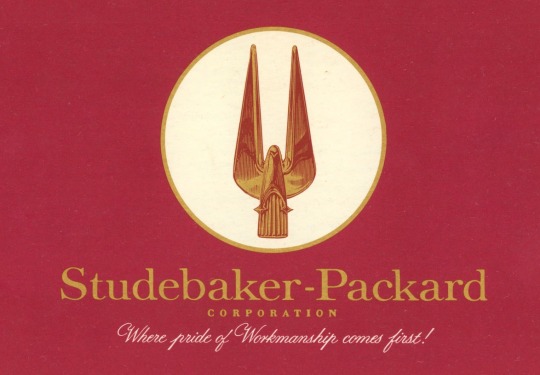






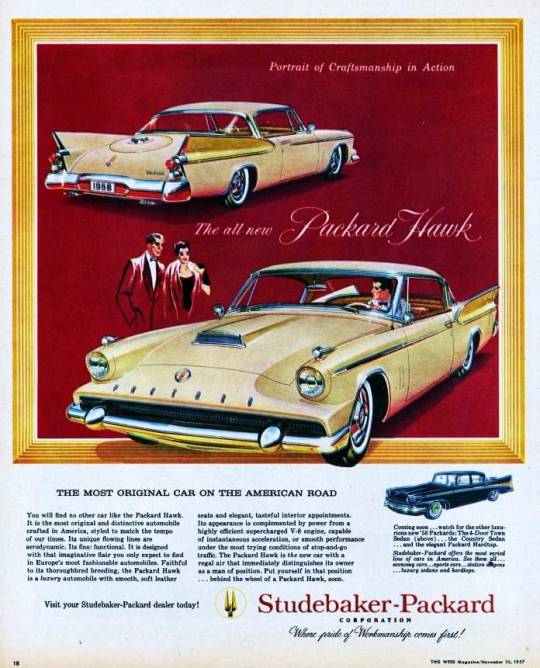
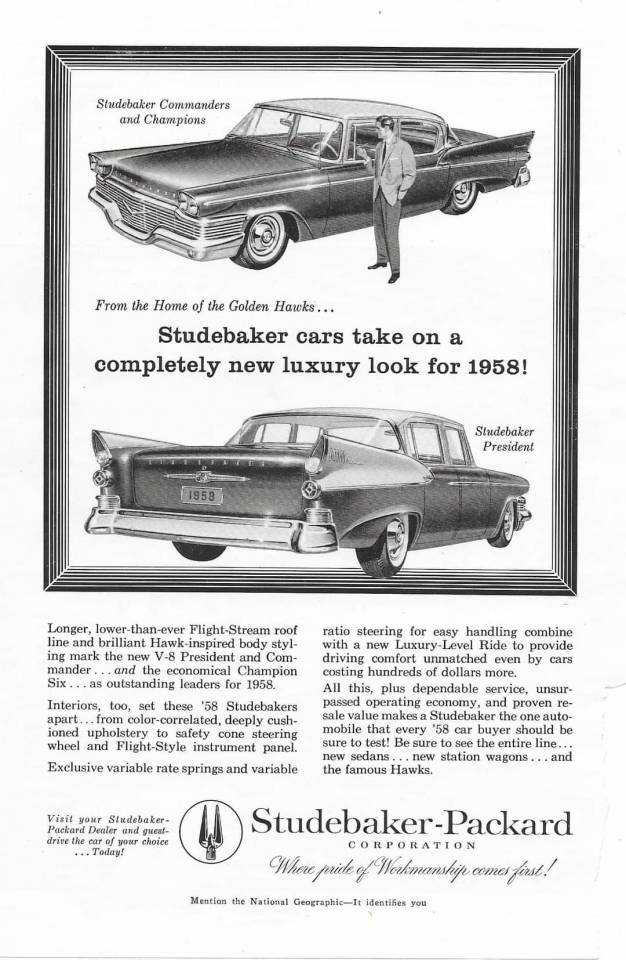
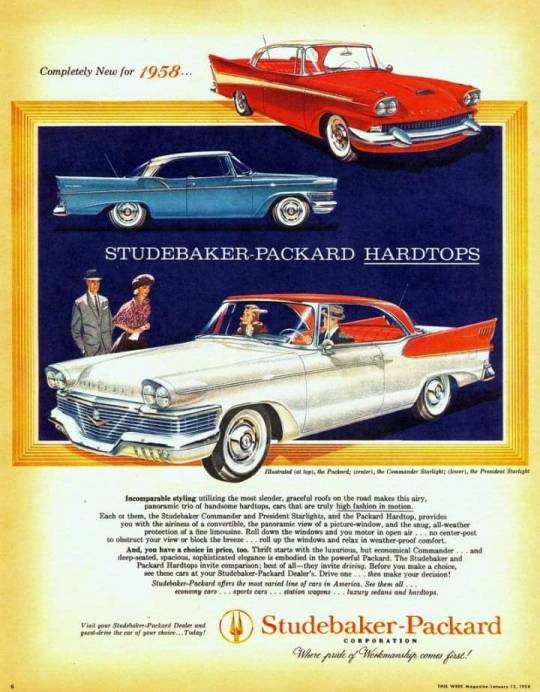
🇺🇲 Step into the mesmerizing world of vintage advertising posters from the legendary Studebaker-Packard Corporation (USA, mid-20th century), where innovation and luxury intertwined to redefine automotive excellence.
🏭 Studebaker's journey began in 1852 as the Studebaker Brothers Manufacturing Company, crafting wagons, buggies, and carriages in South Bend, Indiana. By 1902, they boldly ventured into electric vehicles, paving the way for gasoline cars in 1904 as the "Studebaker Automobile Company."
💡 Teaming up with prestigious entities like the Garford Company and later with the E-M-F Company, Studebaker became a pioneer in automotive innovation, unveiling their fully manufactured gasoline automobiles by 1912.
🌟 Packard, founded in 1899 in Detroit, Michigan, stood as an epitome of luxury and innovation in the automotive industry. Packard vehicles were renowned for their high-quality craftsmanship and pioneering features, including the modern steering wheel and air-conditioning in a passenger car.
🚗 After World War II, Packard faced challenges against the domestic Big Three automakers but maintained its reputation for luxury and innovation.
🤝 Packard's merger with Studebaker in 1953 formed the Studebaker-Packard Corporation, intending to consolidate with American Motors Company. Despite disagreements among executives, this merger showcased the blending of two iconic brands, leaving a lasting legacy in American automotive history.
#Transatlantic Torque#Brits and Yanks on Wheels#american cars#made in usa#made in america#vehicle#brands#companies#studebaker#packard#luxurycars#1950s cars#retro#retro cars#retro aesthetic#michigan#detroit#indiana#innovation#industry#corporations#advertising#posters#commercial#old cars#car#cars#automotive#automobile#studebaker packard corporation
7 notes
·
View notes
Text

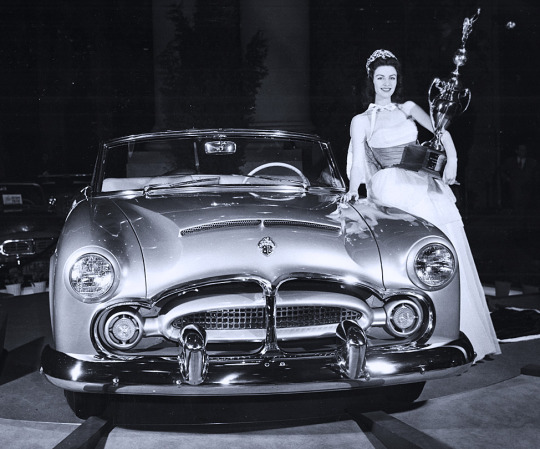
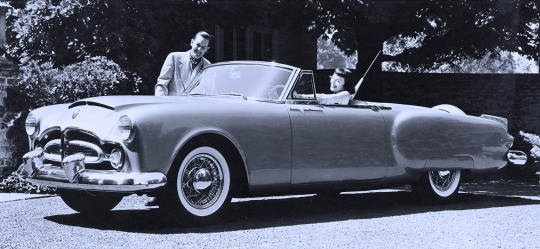

Packard Pan American, 1952. Designed by Richard Arbib, and coachbuilt by hearse and ambulance specialist Henney. The first of 6 cars was build for company president Hugh Ferry. They were based on the Packard 250 convertible, sectioned, channelled and lowered in an attempt to create a top-tear roadster. The projected cost was $18,000, at a time when the top-line Lincoln Capri convertible sold for $3,665, the Cadillac Series 75 Fleetwood for $5643.
#Packard Pan American#Packard#1952#Richard Arbib#limited edition#1950s#dead brands#roadster#Henney#coachbuilt#lowered
147 notes
·
View notes
Text
The one where Gav's an urban legend
---
February 12, 2013
Kazuo spun in his chair, laptop precariously balanced on his lap. Ian glanced over, "If you drop that again, I'm going to get you one of those cases like they put on toddler tablets." "I'm careful. My balance is impeccable." "You fell down the stairs yesterday," Gav didn't even look up from his computer. "Those stairs are a death trap."
Ian looked at the clock, "Another half hour and we can get lunch." "Sounds good." Kazuo spun in his chair again, before kicking his feet up on his desk. He was busy scrolling through Reddit, flitting from one subreddit to the next. Somehow, he wound up on r/Detroit, and immediately took notice of one thread -
What's the weirdest thing you've seen at night?
Kazuo looked at Gav, remembering every weird street story he'd been told. He started scrolling, the usual nonsense popping up - haunted places, I saw Bigfoot at Burger King, the norm. And then….
-
Okay, so when I was a teen, me and my shithead friends would go joyriding in abandoned neighborhoods, blasting music and being assholes, throwing beer bottles and smoking pot. It was a Friday or Saturday, maybe 1 AM. We liked to turn off our headlights to make it creepy, and I know, stupid but we were teens. I don't remember what street it was, but the houses were all burned out, when something ran in front of our car. My girlfriend screamed, and I turned the lights on. There was this ginger kid, beaten up and filthy, flinching away. He looked scared and half crazy, and then I swear to God, he took off running, climbed the side of a house like Spider-man and disappeared. We still don't know what the fuck he was.
-
Oh thank god I'm not the only one who saw that guy. He was fast and nimble. Like a spider. Never said a thing. Saw him in a ton of places, usually after dark while joyriding. Had a wide range and often had a pack of dogs that were NOT friendly. There was a big Saint Bernard type that tore the bumper off my buddy's car. It was held on with duct tape, but it's the principle. Fuckin' Cujo.
-
I see you met the Detroit Dogman. Tiny ginger dude. I saw him with a pack of dogs around the old Packard plant. He stood there and his dogs chased my friends and I out. He was afraid of us. I wonder what his story is, but I haven't seen him in years now, hope he got off the street.
-
Little man, long red hair? I saw that dude stealing beef jerky and roller grill crap from a 7-Eleven. I didn't say a word, he looked malnourished. He left and a pack of dogs materialized out of the alley. Weird.
-
I saw him from a distance, carrying a shovel and a bloody bundle. I followed a bit behind, just in case he was a serial killer, and he buried it in an empty lot. I checked it out after he left and found a huge pet cemetery, markers with names and breeds. It spanned a few blocks. I don't think he's a bad guy, just prefers the company of dogs. Maybe he's a runaway, he looked young.
-
I saw him hauling a big bag of dog food. He was having trouble, but he started running when he saw me following him. His feet and legs were all cut up. He was FAST though.
-
man i saw this lil fucker swimming with a lot of dogs in the detroit river in fuckin november and he had a fish in his mouth like a big ol wiggly fish what the fuckkkkk
-
I saw him multiple times. He was kind of cute in a filthy, matted way. I wanted to ask about his dogs. He made the city interesting. I got close once, and he smelled like dirty Vienna sausages. He noticed and flinched real hard, like he expected me to attack him. Hope he's doing better now, miss seeing him around.
-
My friends and I were drinking in an abandoned K Mart at night when we heard a weird noise. This weird little dude was on the roof, howling at the moon. I threw a Molson bottle and he jumped off the roof and took off running. What the hell.
-
Kazuo started giggling like a complete idiot. These were all about Gav. Gav, who was quietly typing at his computer and listening to music. There were more stories. One reply was just a low resolution photo of Gav and his pack squaring off with raccoons in a Big Boy parking lot. Ian turned slightly, "What are you chuckling about, you degenerate?" Kazuo wheeled himself over, handing off his laptop, "Here. Behold."
Ian started reading, "Oh. Oh my. Um, Gav?" The redhead looked up, "Yeah?" "We have some things you need to read." Gav rolled over, squeezing in to look at the screen, "What's so…oh. This is…about….me?" "You're an urban legend." "Huh. I mean, I know I probably scared a lot of people at night…and urban explorers…but…wow."
"You are a celebrity," Ian shrugged, "Are there more?" "It's a big thread, so maybe." "This is weird." "You okay?" "Well, the attention from strangers is a bit off putting, but that might be the autism." "The raccoon photo is impressive," Ian studied it. "Yeah, we had to fight for the dumpsters. You're not grossed out by me having eaten from dumpsters, are you?"
"We figured you had to do what you needed to survive." "And I've seen Ian drop a gyro in the actual road on Sixth, pick it up, dust it off, and eat it." Gav relaxed, "It was gross, but it helped me feed the group. I could open dumpsters, and they couldn't." "So, are you going to post? You can use my account." Gav thought for a moment, "I think…maybe I should. I know it'll kill a lot of the mystique, but there are people that want to know if I'm okay." "Hang on," Ian took a photo of Gav in front of the computer, "Sending this to your email, Kaz."
Kazuo downloaded it, "Add that to your post." Gav nodded, starting to type.
So, one of my boyfriends found this thread. (This is his account) I am the Detroit Dogman, and I am safe in Texas after leaving Detroit in 2007. I had a really bad home life - I'm gay, and was the unwanted twin, and left at 16 in 2005, though I'd been wandering with my pack since late 2002, when I'd found them while wandering during a night I'd run away from home. We did live in the old Packard plant, though I'd take a few days to get food or try to replace clothes and blankets. I stole a lot, and I'm not proud of it, but I'd also panhandle, scared as I was of people, to get dog food.
We did fish the Detroit river, and it was the only fresh meat I had while on the street. I wouldn't call fast food dumpster diving 'fresh'. Life was rough, but at least I could provide entertaining stories and some scares.
As I said, I'm safe in Texas. Austin. I have two wonderful boyfriends who pulled me off the street, and gave me a home and a job - I'm a paralegal now, my one partner is a lawyer, and I'm happy and healthy now. I'm attaching a photo of me in front of this thread. I look forward to more stories. I had to leave my dogs behind because there was no safe way for us to all travel together. I miss them, and I hope they're okay. My name is Gav, by the way, to put a name to the dirty, bedraggled face.
Signed, the Detroit Dogman
Gav sat back for a moment, before hitting 'post'. "You alright?" Ian cocked his head. "Yeah," Gav said, "It's like I have closure. But I still get to be an urban legend. I'm okay with that." Kazuo draped himself around Gav's shoulders, "You ready for lunch, Dogman?" "Yeah. I think we need chili." "Good choice," Ian stood, stretching, "You've earned it." Gav replaced Kazuo's laptop, "Hard to believe I'm a celebrity." "We'll have to look for more stories," Kazuo grinned. "I want to compile them," Gav pulled on his coat, "Maybe write some sort of memoir -
The Dogman Chronicles."
3 notes
·
View notes
Photo


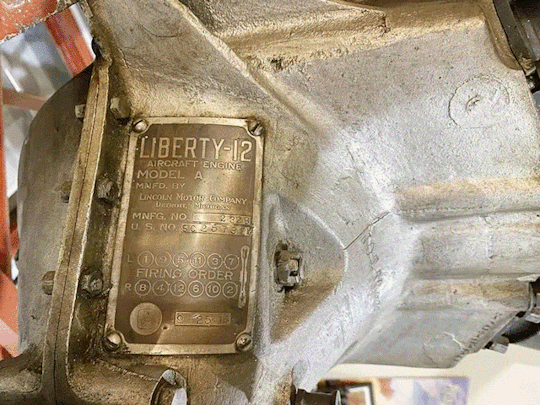
The Packard designed Liberty V12 aero engine, 27 liters, 400 Hp (300 Kw). This one was built by Henry Leeland by his newly founded Lincoln Motor Company, that would later switch to cars, and be absorbed by Ford Motor Company
3 notes
·
View notes